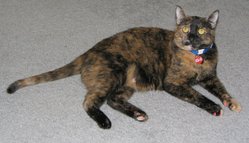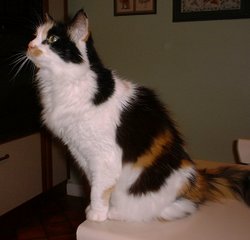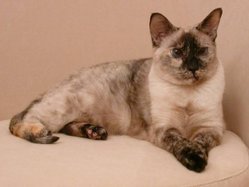 A Blue/Dilute Tortie cat.
A Blue/Dilute Tortie cat.|
MultiMedia |
 A tortoiseshell cat.
A tortoiseshell cat.Tortoiseshell is a coloring found in cats caused by a combination of specific genetic traits. It is a mix of phaeomelanin based colors (red) and eumelanin based color (black, chocolate and cinnamon). The pattern results in a cat with patches of red and patches of black, chocolate or cinnamon. The size of the patches can vary from a fine speckled pattern to large areas of colour. Dilution genes may modify the coloring, lightening the fur to a mix of cream and blue, lilac or fawn. Occasionally silver or ginger tabby patterns are also seen (sometimes called torbies ). Tortoiseshell also can be expressed in the points pattern. The description tortoiseshell (also called 'calimanco' or 'clouded tiger' in North America) is correctly reserved for cats with coats that have no white markings, while those that are largely white with orange and black patches are described as calico (in the US) or tortoiseshell-and-white (in the UK). Tortoiseshells and calicos are not specific breeds of cat. The tortoiseshell markings appear in many different breeds.
Coat coloration in cats is complex. The genes involved include the Orange gene, O, which in its dominant form, XO, produces orange fur, and in its recessive form, Xo, produces black fur.
For a cat to be calico, it must simultaneously express both of the two genes, O and o, which are located at the same location on the X chromosome. Males normally cannot do this: they can have only one allele, as they have only one X chromosome. Over 90% of tortoiseshell cats are females. Occasionally a male calico is born. These may have Klinefelter's syndrome, carrying an extra X chromosome, and will almost always be sterile or they may be a chimera resulting from the fusion of 2 differently coloured embryos.
The Spotting gene causes white patches to cover the colored fur. Although there is no genetic difference, the amount of white is artificially divided into mitted, bicolour, harlequin and van, going from almost no white to almost completely white.
In normal female tortoiseshell cats and in Klinefelter males, the position of the patches depends on which X-chromosome is active in each cell and which is inactivated to become a Barr body.
The Calico Cat is the state cat of Maryland.
Tortoiseshell cats are often called torties.
 A tortoiseshell-and-white (calico) cat.
A tortoiseshell-and-white (calico) cat.
 A tortoiseshell-point
Siamese
cat.
A tortoiseshell-point
Siamese
cat.
See also
References
Cats Are Not Peas: A Calico History of Genetics - by Laura Gould, Copernicus Books, ISBN: 0387947965